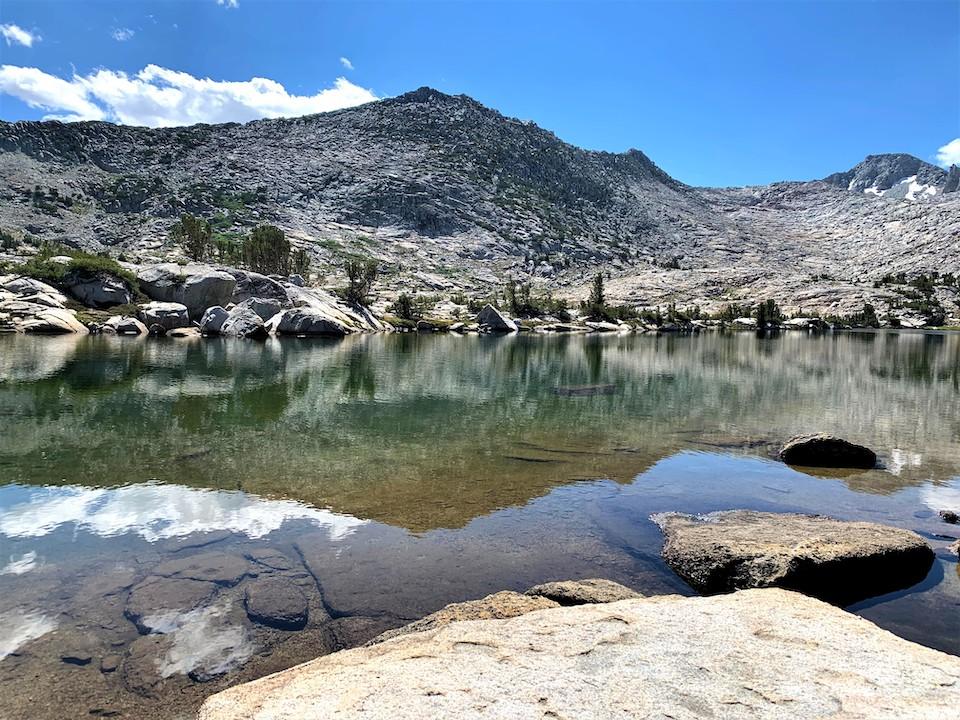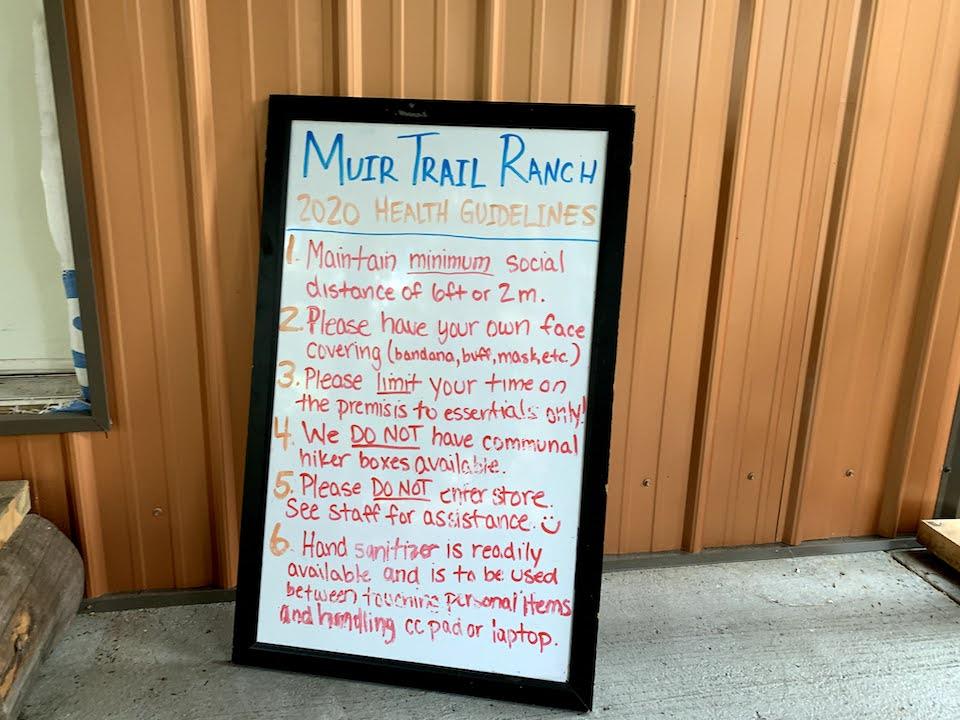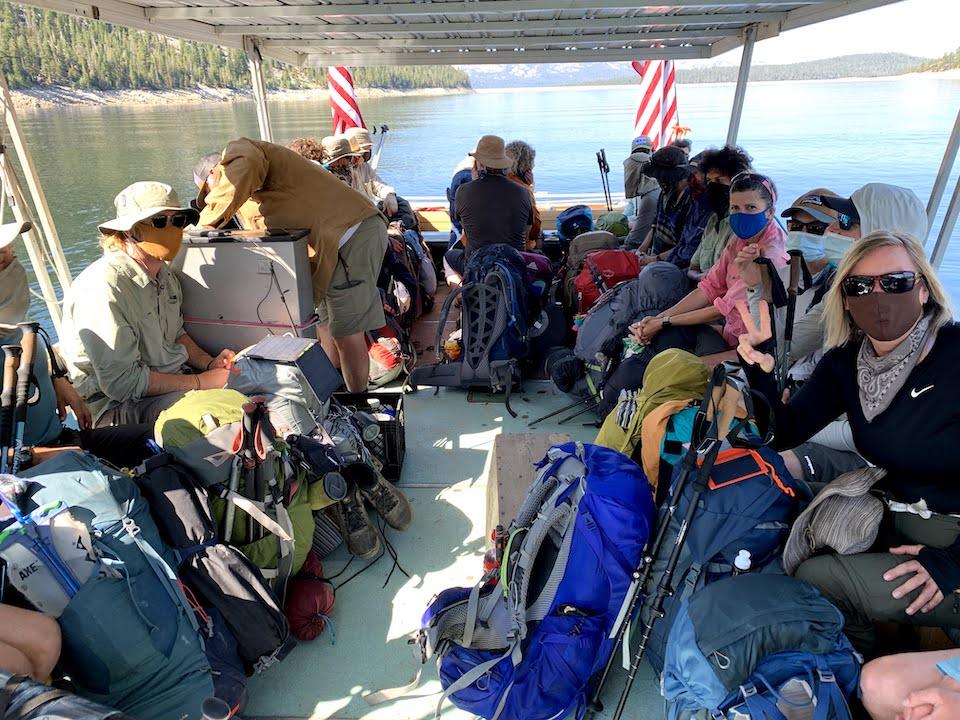
Marie Lake on the John Muir Trail/Rita Beamish
“I can always tell the Bay Area people: they have masks and are strict about it. I appreciate that.” Jim Clement spoke from behind his own face mask and a recently installed, clear plastic barrier on the counter that separates him from the backpackers traipsing in and out of his tiny store at Vermilion Valley Resort, a dusty, High Sierra fishing and hiking outpost on Lake Edison.
“I get a chance to see hikers from around the country” -- they come through for resupply, a shower, and a meal -- said the 66-year-old Clement. “You definitely have people who are concerned – and people who are cavalier” about coronavirus safety protocols.
“People from the Bay Area definitely distinguish themselves by their concern about COVID,” he added.
Even here under the bluest of skies, up off the grid in the Sierra Nevada, along one of the world’s premier wilderness hikes – through Yosemite, Sequoia and Kings Canyon national parks, the John Muir, Ansel Adams and Inyo wilderness areas and the Mount Whitney zone -- the insidious coronavirus has crept into the summer idyll. Outside Vermilion’s creaky store door, beneath the familiar “Hikers! Please loiter” sign, the “Welcome to VVR” chalkboard has a new directive: “Please wear a mask.” Another notice mandates face coverings inside. A hand sanitizer pump bottle sits atop a chopped-off log, with a sign telling everyone to stay six feet apart. At the nearby bear-proof bins, where hikers rummage for food and supplies that others have left for the taking, another sanitizer dispenser is at the ready.

Health guidelines at the Muir Trail Ranch/Rita Beamish
As among the populous down below, hiker attitudes about masking and distancing are divergent, creating sometimes-awkward and even uncomfortable encounters amid the usual bonhomie of the trail. Masks are notably more prevalent nearer to trailheads, less so as people have repeat encounters with new acquaintances in the backcountry. Masks are required on the Edison Lake “ferry” -- which saves hikers a 7-mile trek around the lake to Vermilion – but tend to quickly come off when boots touched the shore.
Clement’s message to hikers arriving from the 211-mile John Muir Trail and the overlapping Mexico-to-Canada Pacific Crest Trail: “Be respectful.”
Some heed that message. Many do not.
“I figure any COVID up here would be the healthy kind,” laughed one maskless young Angeleno on the trail near pristine Marie Lake. He said he’d been unfazed to find people closely mingling unmasked at Blaney Hot Springs not far from the trail.
“I’m all for masking in cities and in stores. If it makes people comfortable, do it,” said New Yorker Sheri Steckler, a 58-year-old special education teacher who stopped for water from a sparkling stream as she toiled up 11,955-foot Muir Pass under a hefty gray backpack. “I don’t think it’s necessary up here when I’ve had it.”
She explained she’d recovered from a March bout with COVID-19, quarantining at home before driving to California to hike the John Muir Trail.
Steckler donated plasma twice, informed that her strong antibodies could help treat others. She saw no problem mingling outdoors, umasked, and sharing pie and ice cream with other hikers at Vermilion.

Face masks were mandatory on the Vermillion Resort's ferry/Rita Beamish
A 52-year-old San Diego hiker was less sanguine about the literal rubbing of elbows she’d seen. “They act like there’s nothing happening,” she said, leaving Vermilion to continue her PCT hike.
Like her, my friend Kirsten Keith and I tried to follow safety recommendations during a recent nine days on the JMT. We pointedly raised our masks when other hikers approached. Many responded in kind or stepped off the trail. Others did not.
When two young women marched toward us barefaced, Kirsten cheerfully announced she’d step off the trail to maintain distance. One snorted and glumly raised her bandana. The other kept moving, eyes down. “Where are you guys from?” I queried politely through my mask. “Palm Springs,” the first one spat as they clomped past.
Kirsten, a former mayor of Menlo Park, found such experiences made this year’s hike “very strange” by comparison to the usual camaraderie of the trail that she relishes. “While it’s so tempting in the backcountry to feel safe, we all have a responsibility to protect each other this summer by wearing a mask when we pass each other on the trail,” she said.
“You can’t see their facial expressions … But it’s something we have to do now, and hopefully we won’t have to next year,” said Frank Barron, 58, a retired city planner from Santa Cruz who was scouting below rocky Bishop Pass for a place to pitch his tent.
“When you’re outside and you have more than 6 feet apart, you’re probably fine,” he added. “I’ll mask up if I’m close to people.”
But at Muir Trail Ranch, a hike-in respite a mile off the trail, where signs implore people to mask up and keep distance, three new hiking acquaintances stood close together, maskless, laughing, and swapping food they’d picked up in their resupply. About 20 feet away three masked hikers sorted their own supplies.
A U.S. Forest Service ranger monitoring backpacker numbers near Senger Creek saw progress: She estimated 25 percent to 30 percent wore face coverings in late July – compared to almost none a month earlier.
At Vermilion, Clement says the pandemic has made its mark on overall backpacker traffic, which is down by half this summer, largely due to absence of international travelers and out-of-staters who flock to the siren song of the High Sierra. Two drive-up groups in one week also canceled their cabin reservations, he said, “because certain members of the group were not practicing safe practices the others didn’t want to be infected.”
But overall, car arrivals are way up, he said, with visitors plying a tortuous, seasonal road from the Fresno area to camp and fish, refugees from the crowds and lowlands where the coronavirus at least seems so much closer.



Comments
Thank you for that very interesting article. I found the same sort of thing during a recent weekend stay in Mount Rainier National Park. I'd say 40% - 50% of people had masks and they wore them at the start of the trail heads and pulled them up whenever they met hikers coming toward them on the narrow trails. Some people I passed who were not wearing masks looked almost defiant when they saw me, while others looked sort of sheepish when they passed me and other hikers who were masked up on the trail.
I too hiked a section of the JMT this summer. For those unaware, the JMT is hundreds of miles long, most of that deep into backcountry (a full day or more from any trailhead). It sees about one party, from one to a few individuals each, about every 15 minutes on average, during prime hiking hours (10AM - 4PM), and many fewer outside those hours. It is a narrow trail where, when parties pass, one party has no option but to step several feet off-trail anyway for the few seconds it takes for the other party to pass on by. Any brief conversation that might ensue, if both parties halt, naturally tends to be conducted 10 or more feet apart, because who really stands closer than that to strangers anyway when in the great outdoors? Encounters at camp are similarly fleeting - most people are interested in solitude, not mingling and socializing between camps, which tend to be 100 feet or more apart from one another.
Given all this, its obvious why so many did not mask-up, and even fewer remained that way, as they toiled for hours along strenuous trail under heavy backpacks deep into backcountry where they never came closer than 6 feet from anyone else for more than two or three seconds a handful of times a day. That's why I didn't have a problem with it, and I don't think you need to have had one either, in those circumstances. If you can point to any evidence of actual transmission ever having actually occurred anywhere, outside, in uncrowded environments, from nothing more than a few seconds of passing, I'll change my mind. I guess we'll know for sure by the end of this JMT season - as you wrote, almost nobody was doing it (in my week-long hike, I think I passed about 3 masked hikers once I was into the backcountry), so chances are that if that is truly dangerous at all, there will be dozens if not hundreds of cases contracted by JMT backpackers by the end of the summer, and the story will eventually emerge. Keep up the reporting and stay tuned!
(PS. Note I'm talking above about on- or off-trail backcountry hiking and passing, not "watering holes" like Vermilion Valley Resort, Muir Trail Ranch, the Edison or Florence Lake ferries, Blayney Hot Springs, trailhead parking lots, etc. Those are locations where multiple backpacking parties congregate and hang-out for 30, 45, 60 minutes or more, sharing space like storage lockers, storefronts, ferries, adjacent parked cars, etc. These are "frontcountry" situations, even when - like MTR - they are located in the backcountry. In such situations, masks are entirely justifiable and, in my experience, almost everyone indeed put on their masks.)